100 Jahre Bauhaus
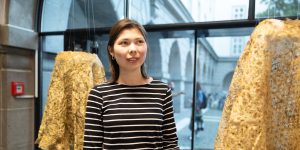
Rhizomes
Freya Probst (DE/UK)
These grown gowns are the outcome of a series of experiments and playful interactions with plants and the observation of their roots through photography or time-lapse video. Experiments with pearls, small gears, or the positioning of seeds lead to different plant responses. The outcome was eventually applied to larger surface areas in the shape of cutting patterns reminiscent of fine woven textiles. The exhibits show a subterranean, hidden aesthetic of a natural structure that cannot be copied by humans.
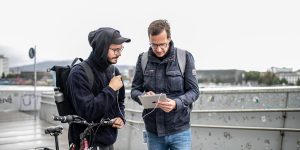
Stereospacer: Nature Space
Michael Markert (DE)
Explore how virtual insect and physical city sounds mix and discover how this experience changes the perception of the area outside the exhibition space.
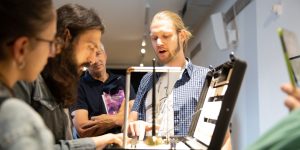
Global Consciousness Interface
Sebastian Kaye (UK/DE)
Global Consciousness Interface is a portable interface that allows users to connect themselves to this net of consciousness whenever they feel the need. As “esoteric electronics,” this device mirrors a part of the tantric approach in Tibetan Buddhist meditation; by using body, speech, and mind, one's totality is applied. Here, the body is reflected in the use of the user's heart rate, the bell symbolizes speech, and the mind is united with itself through this interface.
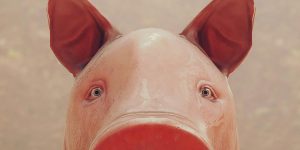
Pig Simulator
Stephan Isermann (DE)
The Pig Simulator takes place in virtual reality but also in real space. The goal is to escape the slaughter in virtual reality – and, as in the real life of the real pig, this idea becomes futile. The user will live and die like a pig and experience the habitat of the animal as closely as possible through the virtual embodiment of an artificial and cruel habitat designed by humans to satisfy our desire for mass consumption of meat. The Pig Simulator may subvert common expectations about gaming and fights the dark irony of a just world of unequal life forms living in the shared habitat called Earth.
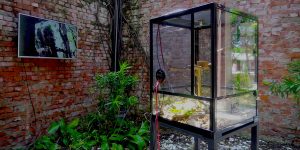
ZoomBx: KTV Sessions Vol II.
Rico Graupner (DE)
ZoomBx: KtV Sessions Vol II. focuses on the experimental exploration for real-time-driven composition of public soundscapes. Sound events and movement patterns inside a terrarium are tracked, interpreted, and acoustically applied to a concrete fusion with the outer soundscape. The result is an automated soundscape composition between randomness and determinism, from which questions about the cultural significance of designed sounds and the originality of acoustic phenomena can be deduced.

close encounter
Jan Georg Glöckner (DE)
Living sculpture (2019) The work displays a fungus living in a 90 liter bioreactor. In the bioreactor the fungus is kept alive by an artificial life support system that supplies it with the water, sugar, and oxygen that are its basic needs. The fungus adapts to this system and transforms its body into round pellets that are submerged into the liquid. The bodily presence of the fungus in the bioreactor offers humans the chance to observe and to reflect about so-called “natural” and artificial habitats.
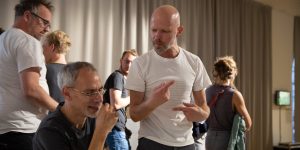
Introduction to Posthuman Aesthetics
Mindaugas Gapševičius (LT/DE)
Installation with devices and videos (2016-2019) These toolkits invite their users to carry out scientific experiments on a DIY level and be able to introduce their simplified, accessible versions to a broader community. The prerogative is to render and outline methods for independent research, opening the black box of empirical experiments to individuals across disciplines. Whether framing the discussion of political, economical, or cultural issues, the toolkits question the creativity of non-humans and do not presume humans to be the only creative force at work.
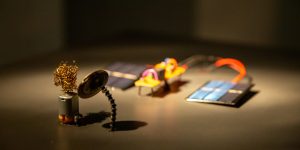
Thoughts on Day and Night
Maike Alisha Effenberg (DE)
By extending mechanical models from the 60s, you will find here a new approach towards nature and ecosystems. Contemplate the equality of the energy flow within a machine and within an organism. Both receive their energy from the light, react to it, and save it for processes at night. At least, this is what we think they do. So how much life do we find in a machine and how much construction do we find in nature?
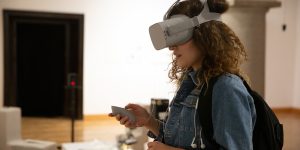
microplastic_hyperobject
Maria Degand (FR/DE), Leon-Etienne Kühr (DE)
Numbers and graphs are the essence of most scientific papers. They try to describe the world, facts, and problems. Microplastics are one of these problems. This artistic research is an example of how people can literally be put in these graphs. It looks at the real problem particle in this particle system. The design of experimental research is set up to simulate the experience of the hyperobject in virtual reality. Experiments on the scale in virtual reality and about connections in virtual space.
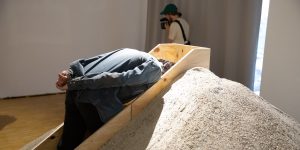
Drosophila Karaoke Bar
Ursula Damm (DE)
Drosophila Karaoke Bar invites visitors to establish a direct exchange with fruit flies through a technical interface that invites visitors to talk and sing with the flies.


